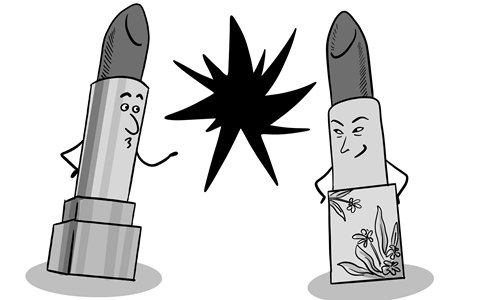HOME >> BUSINESS
Palace Museum’s luxury launch to prompt global brands to follow suit
By Xiao Xin Source:Global Times Published: 2019/11/7 22:53:40
Palace Museum’s luxury arm to prompt global brands

Illustration: Luo Xuan/GT
For young Chinese women obsessed with beauty, the old days when expensive Yves Saint Laurent lipsticks were among the first choices seem to have disappeared. Wearing lipsticks from Beijing's iconic Palace Museum now appears to be the mark of a fashion icon.
Homegrown upstart fashion houses, notably the Palace Museum which is increasingly known as a fashion trendsetter among Chinese young people, are disrupting the country's fashion market from clothing, bags and accessories to cosmetics and fragrances.
The museum's foray into the cosmetics world started with the launch of its lipstick line in December before its announcement of foundation makeup and skincare products last month. Its cosmetics items, going for between several hundred yuan and a few thousand yuan, truly put the centuries-old palace amid established global heavyweights.
But local disrupters still have a long way to go before they can take on the likes of Kering, the parent company of famed brands including Gucci, Saint Laurent and Balenciaga, on the global stage.
That perhaps explains, to some extent, why China's import fair shines a spotlight on France, a longtime fashion capital of the world.
France seems to be in focus at the second China International Import Expo (CIIE), with French President Emmanuel Macron, among four foreign leaders, attending the expo and an array of French businesses making lists of must-see attractions.
Among the most popular booths are those from French luxury and fashion houses, Kering and LVMH included, an indication of France's revered position on the global fashion scene. As a first-timer at the expo, LVMH debuted a wide range of its newest products.
It's clear that French luxury businesses, typifying a multitude of global high-end brands, are focused more than ever on the Chinese market.
The race to success in China's market is best described by US management consultancy McKinsey in an April report that said if a company succeeds in China it will succeed in the global luxury market.
This impressive conclusion was reached based on McKinsey's finding that the nation's luxury market sees no signs of sluggishness despite a cooling economy.
Chinese people spent a total of 770 billion yuan ($110.29 billion) on luxury consumption in 2018, accounting for one-third of global luxury consumption, per the report. Every luxury-consuming household forked out nearly 80,000 yuan per year on average in luxury purchases.
China's luxury purchases are expected to hit 1.2 trillion yuan by 2025, according to the report's findings. That means China's share of the global luxury market, which stood at over 50 percent between 2012 and 2018, would climb to 65 percent.
Unsurprisingly, China has been and will continue to be the most crucial luxury battlefield.
Most encouragingly, younger generations are believed to have bolstered the nation's luxury market, in defiance of the economic slowdown and amid global uncertainty.
Chinese people born post-1980s and post-1990s, unlike the thriftier older generations who tend to save in advance for future needs, are more futuristic when it comes to consumption.
The changing concepts of consumption, the booming mobile internet along with the economic rise and the nation's opening-up mean that young people aspire to be part of the fashion community. The prevalence of internet-based financial services has arguably contributed to the prosperity of luxury goods in China, often to the extent that young people are taking out online loans they cannot afford.
It can be said that the nation's highly developed internet economy and virtual identity are reshaping the nation's consumer market, the luxury segment in particular.
That said, attendance at the CIIE is merely part of global fashion houses' drive to adapt to the local market.
Just as the Palace Museum is doing while pushing to redefine the world's most vibrant luxury market, Kering and LVMH's China marketing agenda should include more design work and brainwork to woo aspiring young Chinese consumers.
While it will still be difficult for the Palace Museum to best Kering, the museum's skyrocketing rise to prominence in the fashion world ought to prompt global fashion names to open fire beyond traditional scenes.
The author is a reporter with the Global Times. bizopinion@globaltimes.com.cn
Newspaper headline: Palace Museum’s luxury arm to prompt global brands
Posted in: INSIDER'S EYE